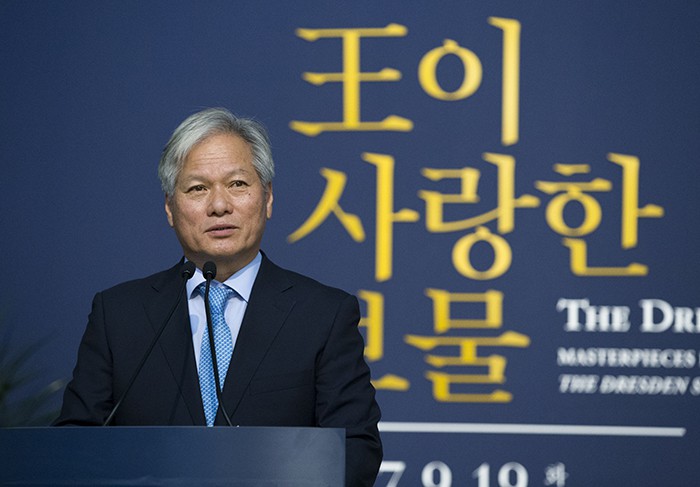
A special exhibition, ‘The Dream of a King: Masterpieces From the Dresden State Art Collections,’ opens at the National Museum of Korea in Seoul on Sept. 19. Some 130 items from the Dresden State Art Collections’ Green Vault, Dresden Armory and Dresden Porcelain Collection are on display.
By Min Yea-Ji and Kim Young Shin
Photos = Kim Sunjoo
Seoul l Sept. 18, 2017
“Here you can appreciate high class artifacts that show the quintessence of 18th century Baroque art in Europe.”
So said Bae Kidong, the director general of the National Museum of Korea, at a press event on Sept. 18, one day before the opening of the special exhibition “The Dream of a King: Masterpieces From the Dresden State Art Collections.”
The exhibition introduces 130 items from the Green Vault, the Dresden Armory and the Dresden Porcelain Collection, all parts of the Dresden State Art Collections.

The uniform worn by Augustus II the Strong is a historical item that reflects the process through which he both lost and then regained the Polish crown during the Great Northern War (1700-1721).
The exhibition is divided into three parts, each with a different theme.
In part one, the properties of Augustus II the Strong, the elector of Saxony and king of Poland, are on display. The exhibits include the military state dress Augustus actually wore during the war, a sun mask made to celebrate his return to the Polish throne, and hunting equipment.

A sword decorated with 911 pieces of rose cut diamonds (left) and a brooch with 369 diamonds were inherited by Augustus III of Poland (1696-1763) from his father Augustus II the Strong (1694-1733).
In part two, the Green Vault, the treasures collected by Augustus II are on display.
The highlight of this exhibition hall of rare and precious treasures is a sword decorated with 911 rose cut diamonds that shows the king’s power and wealth.
Part three consists of porcelain imported from Qing China and Japan that were acquired by Augustus II, and the Meissen Porcelain inspired by East Asian porcelain.
The exhibit also has the first porcelain table set in Europe. The collection, printed with red Chinese dragons and yellow Japanese “lions,” which are actually tigers but which were falsely recorded as lions, were used as the royal table set until the 19th century.

Eva-Maria Strange, the Saxony state minister of science and the arts, said, ‘Here you can see traces of the trade between Saxony and the world,’ at the press event held at the National Museum of Korea on Sept. 18.
“Korea and Germany have been communicating, not only in terms of politics and business, but also in the arts and education,” said Eva-Maria Strange, Saxony’s state minister of science and the arts, at the press event on Sept. 18. “I’m proud to introduce the best works of art from the Dresden State Art Collections.”
The exhibition continues until Nov. 26 in the special exhibition gallery at the National Museum of Korea. The exhibition will then be displayed from Dec. 9 to April 8, 2018, at the Gwangju National Museum.

Bae Kidong, director general of the National Museum of Korea, explains the value of the special exhibition ‘The Dream of a King: Masterpieces From the Dresden State Art Collections,’ at a press event on Sept. 18.
jesimin@korea.kr























